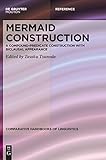Mermaid Construction : A Compound-Predicate Construction with Biclausal Appearance / ed. by Tasaku Tsunoda.
Material type: TextSeries: Comparative Handbooks of Linguistics [CHL] ; 6Publisher: Berlin ; Boston : De Gruyter Mouton, [2020]Copyright date: ©2020Description: 1 online resource (XIV, 868 p.)Content type:
TextSeries: Comparative Handbooks of Linguistics [CHL] ; 6Publisher: Berlin ; Boston : De Gruyter Mouton, [2020]Copyright date: ©2020Description: 1 online resource (XIV, 868 p.)Content type: - 9783110670806
- 9783110670875
- 9783110670844
- online - DeGruyter
- Issued also in print.
| Item type | Current library | Call number | URL | Status | Notes | Barcode | |
|---|---|---|---|---|---|---|---|
 eBook
eBook
|
Biblioteca "Angelicum" Pont. Univ. S.Tommaso d'Aquino Nuvola online | online - DeGruyter (Browse shelf(Opens below)) | Online access | Not for loan (Accesso limitato) | Accesso per gli utenti autorizzati / Access for authorized users | (dgr)9783110670844 |
Frontmatter -- Contents -- Preface -- List of authors -- Maps -- Genetic classification of languages examined or referred to -- 1 Mermaid construction: An introduction and summary -- I. SOV languages -- 2 Modern Standard Japanese -- 3 Mitsukaido dialect of Japanese -- 4 Old and Early Middle Japanese -- 5 Irabu Ryukyuan -- 6 Korean -- 7 Kolyma Yukaghir -- 8 Sakha (Yakut) -- 9 Khalkha Mongolian -- 10 Amdo Tibetan -- 11 nDrapa -- 12 Kathmandu Newar -- 13 Burmese -- 14 Kurux -- 15 Hindi -- 16 Sidaama -- II. SVO languages -- 17 Thai -- III. VSO/VOS languages -- 18 Tagalog -- IV Languages in which the order of S, O and V is not fixed -- 19 Koryak -- Index of names -- Index of languages -- Index of subjects
restricted access online access with authorization star
http://purl.org/coar/access_right/c_16ec
This volume provides detailed studies of the crosslinguistically unusual mermaid construction in seventeen languages of Asia, including Modern Standard Japanese, and one language of Africa. This construction appears to be absent in languages of Europe, Oceania and the Americas. The name - mermaid construction - alludes to its paradoxical make-up, where the structure closely resembling a verb-predicate clause ends with what may look like a noun-predicate clause. Superficially it looks biclausal; however, syntactically it is monoclausal. It has a compound predicate which contains an independent noun, a clitic or an affix derived from a noun, or a nominalizer. Its compound predicate has a modal, evidential, aspectual, temporal, stylistic or discourse-related meaning. The paradox is resolved from a diachronic perspective insofar as a biclausal structure is reanalyzed as a monoclausal one. This volume shows how a noun may be reanalyzed to become a constituent of a predicate. It constitutes an important contribution to research on grammaticalization and in particular, the grammaticalization of nouns and more generally, to the typology of syntactic reanalysis.
Issued also in print.
Mode of access: Internet via World Wide Web.
In English.
Description based on online resource; title from PDF title page (publisher's Web site, viewed 25. Jun 2024)


